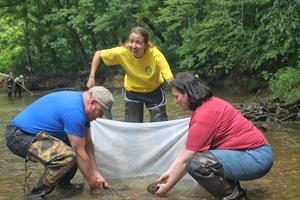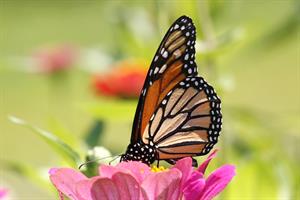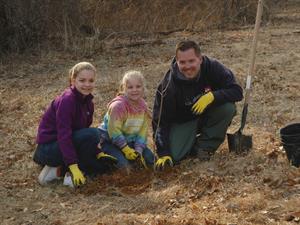Izaak Walton League members are smart, thoughtful people. In the 1950s, legendary League Conservation Director Joe Penfold thought up a national commission to evaluate outdoor recreation resources. Appointed by President Dwight D. Eisenhower to serve on that commission, Penfold helped craft the recommendation for a fund to acquire land for outdoor recreation and the conservation of America’s natural heritage. Ikes worked with colleague groups to make it happen, and the Land and Water Conservation Fund became law in 1965. To date, it has funded more than 41,000 conservation and recreation projects and secured nearly 5 million acres of land for public outdoor enjoyment. (You can read more about it on page 40.)
Long before the 1960s, League members had the notion that companies and individuals ought to take responsibility for the pollution they were creating and sending downstream. So our earliest members made clean water a national priority and laid the groundwork for what ultimately became the Clean Water Act of 1972.
Ikes have had a hand in most of the major conservation accomplishments of the past century. But Ike ingenuity runs deeper than national policies. League members have created blueprints for portable archery targets, protocols for citizen stream monitoring, and a patent to reach the full efficiency potential of LED lights. Some Ikes are working with the Wounded Warrior Project® and similar groups to give injured military veterans a place to enjoy the outdoors, while other League members are working with the National Park Service to develop a mobile rapid response system for invasive species arriving in the ballast water of cargo ships.
If there’s a conservation problem, there’s probably a League member – or many – dreaming up a way to fix it. Ikes don’t always agree, but one thing that seems to bind us together is getting things done. In the spirit of this can-do approach to conservation, the League is focusing on real-world solutions to today’s threats to our soil, air, woods, waters, and wildlife.
Water
Our conservation line-up leads off with work to clean up the nation’s waters. Water pollution was the greatest concern of our 54 founders in 1922 and remains a top priority for 21st-century Ikes.
At the national level, the most important thing any Ike can do right now to improve water quality is to support the new “clean water rule.” This rule, finalized by the Army Corps of Engineers and Environmental Protection Agency (EPA) in May, protects the small streams and wetlands that are the source of the waters we use for drinking, fishing, and swimming and that provide important habitat for fish and wildlife. If we can protect headwater streams from pollution and wetlands from being drained, waters downstream will be cleaner and healthier.
 This doesn’t mean efforts to protect America’s waters have been well-received by everyone. Industries that may have to change some of their behaviors are working with members of Congress to delay — or completely eliminate — the new clean water rule. This opposition continues despite extensive scientific and public review. The rule is well grounded in science and very well supported by the public — including 4 in 5 hunters and anglers, according to one poll. Nonetheless, attacks on the clean water rule will continue through 2016 (at least), and the League’s top national policy priority is to fend off these attacks.
This doesn’t mean efforts to protect America’s waters have been well-received by everyone. Industries that may have to change some of their behaviors are working with members of Congress to delay — or completely eliminate — the new clean water rule. This opposition continues despite extensive scientific and public review. The rule is well grounded in science and very well supported by the public — including 4 in 5 hunters and anglers, according to one poll. Nonetheless, attacks on the clean water rule will continue through 2016 (at least), and the League’s top national policy priority is to fend off these attacks.
At the local level, we have more ways for people to keep waters clean than you can shake a divining rod at. Want to know if you should let your kids or your dog swim in that neighborhood stream? Check the water quality using Save Our Streams — our nation-leading citizen stream monitoring program. As for how your state is doing monitoring its waters and keeping them clean, we are putting together a report ranking each state that will also highlight how you can help. Want to get the kids involved in monitoring water quality? Use Creek Freaks to get their feet wet and encourage a life-long love of the outdoors. Want to start protecting water quality from your own backyard and maybe get your neighbors to join in? Our “Lands Green, Waters Clean” Web site has the tools you need.
Every neighborhood creek feeds into much larger waterways. League members and staff are coming together to figure out how we can contribute to the best strategies for restoring our nation’s great waters. For example, our contributions to recovering the Missouri River include extensive public education and projects to build awareness and respond to threats. We are taking a wholistic approach to restoring the Upper Mississippi River and a focused approach to specific problems such as invasive species and disappearing fish habitat in the Great Lakes, Chesapeake Bay, and Everglades.
Wildlife and Woods
In the water and on dry land, wildlife and habitat are at the top of Ikes’ list of important natural resources. Whether we are hunting, fishing, bird watching, or just keeping a lazy eye out while we golf, wildlife makes our time outdoors more enjoyable. Without healthy habitats — and healthy state and federal agencies to manage wildlife and habitats — our outdoor recreation opportunities diminish (as do the economies that depend on them).
The Land and Water Conservation Fund that Joe Penfold helped launch more than five decades ago — which has provided Americans so many opportunities to enjoy community parks and large public lands — expired September 30, 2015. (It was written with a 25-year lifespan and reauthorized for another 25 years.) Not only does this program fund acquisition of national public lands, it also provides matching grants to states and communities to create parks and recreation resources. Reauthorizing this landmark law is our second highest national priority.
One project that could benefit from a continued Land and Water Conservation Fund is the effort to establish a wildlife refuge in the former Grand Kankakee marshlands. A hundred years ago, this area in Indiana and Illinois was one of the nation’s largest inland wetlands and provided some of our best fishing and hunting opportunities — before the water was mostly drained away for farming and development. With a renewed national focus on making the outdoors accessible for people living in urban areas, and the former marsh just 50 miles south of Chicago, it is time to make this area a national wildlife refuge! The U.S. Fish and Wildlife Service has started the process — and it’s about time too. The League has been calling for a refuge here since 1933, with the Indiana and Illinois Divisions leading the charge. It would be a proud complement to other great Midwestern landscapes we helped protect, including the Upper Mississippi River National Wildlife and Fish Refuge and the Boundary Waters Canoe Area Wilderness.
 At the local level, members at individual League chapters can have a big impact by working together on a common issue. And they can have an even bigger impact by working in concert with other League chapters across the country. One example is restoring habitat for monarch butterflies and other pollinators. Monarchs rely on the same resources as many other pollinators, so their numbers can be a good indicator of pollinator habitat health. Unfortunately, the numbers are not good. Populations of this brilliant orange and black butterfly have declined by around 90 percent due to habitat loss, largely from modern agriculture practices that do a very good job of eliminating weeds. One of those weeds, however, is absolutely necessary for Monarch survival: the milkweed. In America’s heartland, League chapters with land, enthusiastic members, and good neighbors can help reverse this trend and at the same time improve the stability of our pollinator-dependent agriculture system.
At the local level, members at individual League chapters can have a big impact by working together on a common issue. And they can have an even bigger impact by working in concert with other League chapters across the country. One example is restoring habitat for monarch butterflies and other pollinators. Monarchs rely on the same resources as many other pollinators, so their numbers can be a good indicator of pollinator habitat health. Unfortunately, the numbers are not good. Populations of this brilliant orange and black butterfly have declined by around 90 percent due to habitat loss, largely from modern agriculture practices that do a very good job of eliminating weeds. One of those weeds, however, is absolutely necessary for Monarch survival: the milkweed. In America’s heartland, League chapters with land, enthusiastic members, and good neighbors can help reverse this trend and at the same time improve the stability of our pollinator-dependent agriculture system.
Soils and Agriculture
Speaking of our agriculture system, about half our country’s land is devoted to agriculture in some way. Conserving soils, wetlands, grasslands, and wildlife on these lands is a long-standing League priority. One of the reasons the League has such a successful history with promoting conservation on farmlands is that many of our members are involved in agriculture or live close enough to farms that they can have an honest conversation with farmers about conservation.
 Our agriculture work focuses heavily on national policy because farming in America is directly influenced by federal farm programs and subsidies. We recently had huge success in protecting wetlands and highly erodible soils with a Farm Bill requirement that farmers who accept federal subsidies for crop insurance premiums must adopt basic conservation practices in return. As we work to ensure this and other farm conservation programs are implemented as intended, we are also looking to other agriculture conservation priorities, such as:
Our agriculture work focuses heavily on national policy because farming in America is directly influenced by federal farm programs and subsidies. We recently had huge success in protecting wetlands and highly erodible soils with a Farm Bill requirement that farmers who accept federal subsidies for crop insurance premiums must adopt basic conservation practices in return. As we work to ensure this and other farm conservation programs are implemented as intended, we are also looking to other agriculture conservation priorities, such as:
- Bolstering the declining Conservation Reserve Program (CRP), which for 30 years has protected sensitive lands and valuable ecosystems by paying farmers to keep them out of agricultural production.
- Supporting working lands programs, including the Conservation Stewardship Program, that provide incentives for farmers to voluntarily implement conservation on their lands while keeping those lands in production.
- Using federal farm programs to reduce water pollution. Nutrients coming off farms, lawns, and other sources cause problems downstream, including by fueling algae in the water to the point that the water becomes toxic. One such “algal bloom” shut down the drinking water source for Toledo, Ohio, last year.
States also play a huge rule in how natural resources are managed on farms. Stream buffers and state nutrient reduction strategies are tools states can use to reduce pollution from agriculture lands. League members at the state and local levels can advocate for these programs and make them more effective.
Perhaps our greatest opportunity to influence what happens to wetlands, wildlife, and water on America’s farms is by League members reaching out in their community to talk about farm conservation issues of local or regional interest. (For example, the pollution of Toledo’s drinking water and what can be done to prevent it.) Finding new supporters of farm conservation programs, regardless of their motivation — which could be human health, hunting, or clean water — will help move good farm conservation policy forward. And welcoming neighboring farmers into the discussion could help everyone understand one another’s issues and concerns better and lead to new relationships in conservation.
Conservation Across the Nation
From national-level policy to on-the-ground collaboration, the League and our members are working in hometowns and across the country to advance common-sense solutions to today’s conservation challenges.